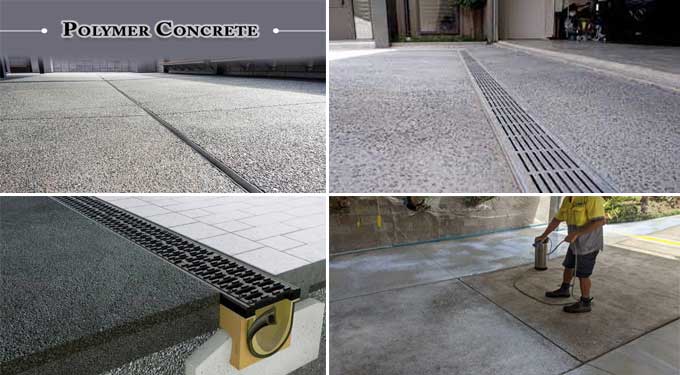
Uses & Properties of Polymer Concrete

Concrete is porous for a number of reasons. Air or water voids may cause the porosity of concrete. One of the reasons for the porosity of the gel structure may also be the inherent porosity of the gel.
A major aspect that affects the strength of concrete is its porosity, which is one of the factors that have an impact on it. High-porosity concrete is characterized by a lower strength of concrete, and low-porosity concrete is characterized by a higher strength of concrete.
A new type of building material called polymer concrete, which was developed by combining modern technology with polymer chemistry and the age-old technology of cement concrete, led to the creation of new building materials.
Polymer Concrete
Polymer concrete is a type of concrete in which polymers are used as binding agents instead of cement. The lime-type cement is replaced in this type of concrete.
The polymer resin is used with or without Portland cement. If the polymer concrete is made only with polymer resins. If the polymer resin is mixed with ordinary cement, then the mixture is known as Polymer Modified Concrete.
Traditional concrete is puros due to the presence of air voids, water bodies, or the inherent porosity of the gel structure itself. Because of the porosity, the strength of cement is normally diminished.
One of the most recent approaches taken toward reducing the inherent porosity of the concrete has been through the impregnation of monomers in the concrete and its subsequent polymerization. An example of this type of concrete is polymer concrete, which is made up of polymers.
Properties of Polymer Concrete
Here are a few properties of polymer Concrete:-
1. It costs more to use a polymer as a binder than cement.
2. Due to its strong adhesive properties, reinforced Portland concrete has a higher tensile strength when compared to unreinforced Portland concrete.
3. The polymer concrete's compressive strength is on par with or higher than that of Portland concrete.
4. Concrete made of polymers has extremely little water and absorbent solution permeability.
5. Chemical assaults cannot harm polymer concrete since it is chemically resistant.
6. Concrete made of polymer is protected against carbonation since carbon dioxide cannot enter.
7. Compared with ordinary cement concrete, it is lighter and less dense, which reduces its dead weight.
Preparation of Polymer Concrete
The materials used to create polymer concrete are thermosetting resin and thermoplastic polymers. Due to its strong temperature resistance and range of chemicals, the usage of thermosetting resin is more appropriate. Polymer resin and particles make up polymer concrete. The aggregate serves as the compressive stress material, while the polymer resin serves as the binder.
A successful aggregate has to be dry, made of high-quality materials, with clean, dust- and debris-free gravel. These requirements must be met on all counts, as failure to do so will affect the concrete's capacity to bond.
Concrete is made up of the following aggregates:-
1. Quartz,
2. Silica,
3. Granite shards,
4. Calcite gravels,
5. and other strong materials in compression.
Benefit of Polymer Concrete
1. Very small cross sections can be used to apply polymer concrete.
2. Limiting the entry of carbon dioxide prevents carbonation and the subsequent loss of alkalinity in concrete.
3. Very excellent corrosion and chemical reactivity resistance are provided by polymer concrete.
4. Polymer binders are helpful for mending existing buildings because they are set up rapidly and provide resilience to the effects of weathering.
Drawbacks of Polymer Concrete
1. When mixing polymer concrete, extreme precision and ability are required.
2. Two-component materials might be improperly proportioned, thus the right mix design is necessary.
3. Masks and hand gloves must be used for skin protection since the chemicals or resins used in polymer concrete might be dangerous.
Application of Polymer Concrete
Both new building and maintenance operations are successful when polymer concrete is used. The polymer may be utilized to repair both polymer concrete structures and conventional cement concrete structures since it has excellent adhesive properties.
There is no requirement for coatings or welding on pipe structures due to the fact that the polymer concrete itself acts as the welding material, so they require no coatings or welding at all.
To learn more, watch the following video tutorial.
Video Source: Anime_Edu - Civil Engineering Videos
For the purpose of improving the durability and strength of asphalt pavements, polymer concrete can also be used as a bonded wearing course and it can also be applied on asphalt pavements.
This type of concrete is utilized for specialized construction projects where it is needed to have corrosion resistance and to be durable, that is to last for a long period of time, i.e. to resist corrosion for a long period of time. As with ordinary concrete, it can be used in the same way.
Conclusion
Finally, polymer concrete is frequently employed in a variety of applications, including enhanced repair techniques, structural uses, architectural components, etc. Therefore, it is crucial for users to understand the advantages and disadvantages of the polymer they employ to create polymer concrete.


